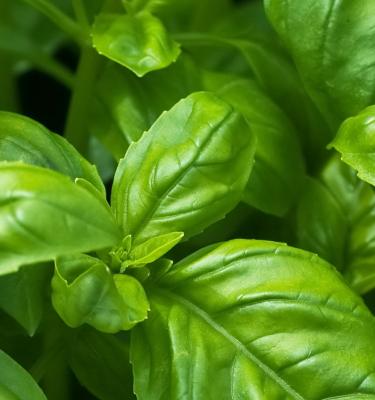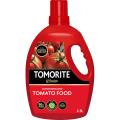

How to grow basil
No kitchen should be without a basil plant. Cultivated in herb gardens for centuries, it’s one of the easiest herbs to grow from seed and it makes a delicious addition to so many dishes. Grow sweet basil (Ocimum basilicum) for tasty Italian cooking, or Thai and lemon basil (Ocimum tenuiflorum, Ocimum x citriodorum) for exciting Asian dishes.
Types of basil to grow
As well as the popular sweet basil, there’s a whole range of other basil varieties available. Here are a few of the most popular:
- Basil ‘Sweet Green’ – traditional sweet basil, ideal for Italian dishes.
- Basil ‘Genovese’ – stronger flavour and aroma than sweet basil.
- Basil ‘Christmas’ – a cross between Genovese and Thai basil. The leaves have a fruity, mulled-wine scent. Also good as an ornamental plant, with purple flowers.
- Basil ‘Crimson King’ – a very ornamental purple-leaved basil. The leaves have a clove flavour.
- Basil ‘Siam Queen’ – a Thai basil with liquorice-flavoured leaves, purple-red stems and violet flowers
- Basil ‘Mrs Burn’s Lemon’ – delicious lemon-flavoured leaves.
- Basil ‘Lettuce Leaf’ – crinkled leaves with a mild flavour, good in salads
Essential equipment to grow basil
You will need the following equipment to grow basil at home:
- Basil seeds
- Pots
- Multipurpose compost
- Propagator or clear plastic bags
Where to grow basil
When growing basil, choose a sunny, sheltered spot with well-drained soil. Planting basil in raised beds improves drainage and gives some protection against slugs and snails. You’ll also find that basil is ideal for pots, even growing happily indoors on a sunny windowsill.
How to sow basil
You can sow basil indoors from late February onwards.
- Fill pots with multipurpose compost and firm down.
- Sprinkle seed thinly over the top of the compost. Basil seeds germinate easily, so don’t sow many more than you need.
- Cover the seeds with a light layer of compost.
- To avoid disturbing the seeds, stand the pots in a tray filled with water so that the compost can soak up water from below.
- Place the pots in a propagator at a temperature of 15-25ºC (59-77ºF). Alternatively, place a clear plastic bag over each pot and place the pots somewhere warm with bright indirect light until the seeds germinate.
- Water regularly but lightly.
- Once the seeds have germinated, take them out of the propagator, or remove the plastic bags and let the seedlings grow on until they have developed at least two true leaves (these are the second pair of leaves to appear).
- Hold each seedling by a leaf (never hold the stems, as these are easily damaged) and ease it out of the compost, using a pencil or something similar to help. Repot each seedling into its own individual pot.
- Wait until all danger of frost is past before moving basil outside. Harden plants off for two weeks first by placing the pots outside during the day and moving them back inside at night.
Caring for basil
Basil hates sitting with its roots in cold, wet soil. Water in the morning so that the soil can dry out during the day. Avoid splashing the leaves when watering, to reduce the risk of powdery mildew, a fungal disease.
If you are growing basil primarily for use in the kitchen, pinch off any flowers that appear, as the leaves will develop a bitter taste once the plant has flowered.
Aphids can be a problem, especially on indoor plants. Wipe them off by hand before infestations get too big. Leaving the plants outside for a few days to allow natural predators like ladybirds to eat the aphids can reduce the problem.
Slugs and snails love basil and can devour entire plants, There are various ways to protect plants, including copper tape around pots, crushed egg shells, beer traps and sawdust, but physically checking the plants with a torch last thing at night is often the most effective solution.
Harvesting basil
You can harvest basil throughout summer, and regular harvesting will encourage the plant to produce more leaves.
If you just need a few leaves, pick individual leaves that join the stem just below a new pair of leaves. This means that for every leaf you pick, the plant produces two more. When harvesting basil in quantities, always leave two or three sideshoots below the point where you cut, to encourage the plant to grow bushy.
In mid- to late summer, cut the whole plant back by a third to encourage a final flush of leaves.
Basil won’t survive outside once the temperature drops below 5ºC (41ºF). For a supply of basil leaves into late autumn, move container-grown plants to a sunny indoor spot.
Storing basil leaves
It can be difficult to keep basil plants growing indoors in low winter light levels, but you can freeze or dry basil leaves to give you a supply of basil through winter.
- To freeze basil leaves, remove all leaf stalks and wash the leaves. Blanch the leaves in boiling water for a couple of seconds, then drain and rinse in iced water. Pat the leaves dry and place in an airtight container in a freezer.
- To dry basil leaves in an oven, turn it on to its lowest heat, then place the basil leaves on a baking tray and leave them in the oven for two to four hours until they crumble when bent.
- To air-dry basil, cut leafy shoots with long stems, tie them in bunches and hang the bunches somewhere cool and well ventilated, in bright but indirect light. Air-drying basil takes about a month.
Common pest or disease problems of basil plants
Black spots on basil leaves
Black spots on basil leaves can be caused by bacteria from the soil being splashed onto the leaves of the plant.
- Avoid splashing the leaves when watering.
Powdery mildew
Powdery mildew is a fungal disease that appears as a white powdery deposit or white spots on basil leaves, stunting growth and causing leaves to shrivel. Drought-stressed plants are more susceptible to this disease.
- Dig organic material into the soil before planting to improve soil water retention.
- Space plants when planting to ensure good air circulation.
- Remove any affected leaves promptly.
- Water regularly in dry periods.
Fusarium wilt
Fusarium wilt is a soil-borne fungal disease that causes basil leaves to turn yellow and wilt. The plant becomes unable to take up water and dies.
- There are no chemical controls available.
- Avoid planting basil in soil where basil plants have been previously affected by fusarium wilt.
Slugs and snails
Slugs and snails love basil and will strip plants bare. They can be identified by the slime trails that they leave, as well as the damage they do.
- Check plants at night and remove slugs and snails by hand.
- Covering the soil around plants with crushed eggshells or grit may have some effect.
- Scatter environmentally friendly slug pellets if other methods are not sufficient.
Glasshouse whitefly
Glasshouse whitefly suck plant sap and excrete a sticky substance called ‘honeydew’ which covers leaves and encourages the growth of sooty mould, stunting plant growth. They can also transmit viruses.
- A parasitoid wasp can be used as a biological control.
- Keep gardens clear of weeds which can harbour whitefly.
- Use pesticide sprays suitable for use on edible plants.
Glasshouse red spider mite
Glasshouse red spider mite is a sap-sucking mite. Severe infestations cause plants to drop leaves and eventually die. Symptoms include a fine webbing covering leaves and stems, and mottled leaves with tiny mites and eggs on their undersides.
- Ensure good ventilation in greenhouses.
- Mist plants to raise the humidity levels, or damp down greenhouse floors.
- A predatory mite can be used as a biological control.
- Use pesticide sprays suitable for use on edible plants.
Key features of basil
| Foliage season(s) | Spring, Summer, Autumn, Winter |
|---|---|
| Sunlight | Full sun |
| Soil type | Chalky, Clay, Loamy, Sandy |
| Soil pH | Neutral |
| Soil moisture | Moist but well-drained |
| Ultimate height | Up to 50cm (20in) |
| Ultimate spread | Up to 30cm (1ft) |
| Time to ultimate height | 6 months |




